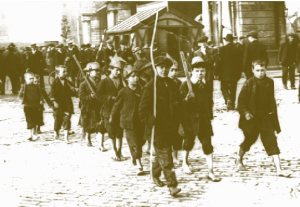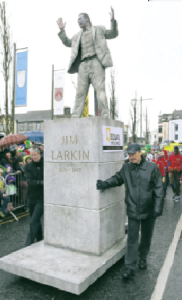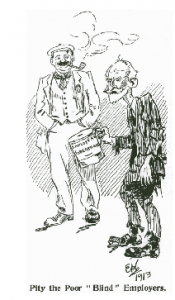Class dismissed?
Published in 1913, 20th Century Social Perspectives, 20th-century / Contemporary History, Decade of Centenaries, Issue 4 (July-August 2013), Platform, Volume 21
Children of a ‘degraded class’? A group of barefoot children ‘on manoeuvres’ in Dublin c. 1914. (Cashman Collection)
Brian Hanley asks whether commemoration of the Lockout means that awkward questions about class and power in Ireland are ignored.
Over the weekend of 30–31 August 1913, a few days into what was to become a five-month-long lockout, the Dublin Metropolitan Police ran amok across inner-city Dublin, attacking strikers and their supporters. Two men died after being batoned, hundreds were injured and many tenement homes were wrecked in vindictive police raids. The Irish Catholic reported that into Dublin’s streets
‘. . . there have poured all the foul reserves of the slums, human beings whom life in the most darksome depths of a great city has deprived of most of the characteristics of civilisation. In the majority of instances they are beings whose career is generally a prolonged debauch, seldom broken by the call of labour. Even when sheer necessity compels toil, it is undertaken unwillingly and merely to obtain the means to enable another spell of besotted idleness. They are essentially birds of night, and foul birds at that.’
That newspaper was owned by William Martin Murphy, whose determination to crush James Larkin’s union drove the policies of the Dublin employers during the Lockout. But the language used was instructive and mirrored that of other observers during the strike. A priest who gave evidence at the official inquiry into the riots described how women and children of a ‘degraded class’ had behaved like ‘frenzied lunatics’ and asserted that the ‘behaviour of the police was the only redeeming feature of what was for a Dublin citizen a really humiliating and disgusting spectacle’.
This language helps to illustrate the key issues at stake in 1913. This was a struggle about class and power: with Home Rule on the horizon at last, about which class would dominate self-governing Ireland. While 1913 remains the iconic moment in the history of Irish trade unions, the labour movement usually references it as a dispute about union recognition. This ignores the fact that Murphy and many Dublin employers had no difficulty dealing with what they saw as ‘respectable’ unions: it was the ITGWU’s militancy and effectiveness to which they objected. The organisation of many of the poorest and most marginal workers in Dublin was what struck fear into the employers.
Calling for the Lockout to be included among the ‘decade of centenary’ events, former taoiseach John Bruton has spoken of how those like Larkin ‘who worked for decent living conditions and a more egalitarian society’ should be remembered. But Larkin and James Connolly were fighting for something more than ‘decent living conditions’ and their definition of ‘a more egalitarian society’ would surely differ from those who retrospectively pay lip service to such an ideal.
James Larkin’s definition of trade unionism was based on that of revolutionary syndicalism: ‘one society for Ireland for skilled and unskilled workers, so that when a skilled man is struck at, out comes the unskilled man, and when an unskilled worker is struck at, he will be supported by the skilled tradesman’. Commentators who abhor strike action today can hardly applaud the tactics of the ITGWU in 1913. In fact, most contemporary Irish middle-class opinion, nationalist and unionist, supported the employers. (Those who refused to allow a float commemorating the Lockout to take part in this year’s St Patrick’s Day parade were, whether they knew it or not, at least being consistent.)
Bruton has been equally insistent that the Home Rule party of John Redmond be given their appropriate place in the forthcoming commemorations. But any consideration of that party should also examine their despicable role during the Lockout, when their fear of Larkinism overrode their claim to be friends of labour.
The emphasis on 1913 as the high point of Irish labour (and often the only aspect of Irish labour history that finds its way onto school curricula) means that other, more problematic areas of class struggle are ignored. The ITGWU was defeated in 1913 but by 1920 had grown to over 120,000 members, many of them farm labourers in the south-eastern counties. But the strikes and land agitation of the 1918–23 period are remembered by few other than labour historians. Events like the 1923 postal strike, broken at the point of bayonets, or the setting up of the Special Infantry Corps of the Free State Army, in the midst of the Civil War, to deal with agrarian and industrial unrest pose more problems for commemoration than the Lockout, which occurred under British rule. Many, including historians, seem happy enough to accept Kevin O’Higgins’s self-serving claim that Sinn Féin were among the ‘most conservative revolutionaries ever’ rather than dwell on the many instances of working-class militancy during the revolution.
A century after 1913, the poverty of Strumpet city is taken for granted while William Martin Murphy is easily painted as a cartoon villain. Yet Murphy was exactly the type of ‘risk-taker’ who would have been lauded in the Ireland of the recent boom. Indeed, in 1913 he was a living contradiction of the Unionist claim that Catholics would never be able to manage a modern economy. The first real Irish ‘media mogul’, Murphy’s press empire is dwarfed today by the control of the bulk of the Irish media by just two men, who utilise this control for political purposes as effectively as he ever did (and Murphy, for all his faults, was not resident outside Ireland for tax purposes).
Dublin’s poverty was an accepted fact in 1913. But often the poor themselves were held responsible for their plight. The areas where the Lockout was fought, the north and south inner city, remain among the most deprived in Ireland, their residents often dismissed in terms not unlike those of the Irish Catholic in 1913. Many who would never dream of using racist language casually sneer at ‘skangers’ and ‘scumbags’, and disdain for Dublin’s poor informs public attitudes on issues such as social welfare and drug addiction. The violence of the Dublin Metropolitan Police in 1913 was not unrelated to the fact that they were recruited overwhelmingly from the sons of the farming class who had little sympathy or empathy for those they policed in Dublin.

The Jim Larkin float at Galway’s 2013 St Patrick’s Day parade. The organisers of Dublin’s parade, who deemed it ‘inappropriate’, were, whether they knew it or not, at least being consistent. (Joe O’Shaughnessy)
Nor should the Lockout be seen as a dress rehearsal for the Easter Rising. While many of those who played a key part in the Rising had been active in 1913, the majority of those who took part in the Lockout were observers, not participants, in Easter Week. (And at least 2,000 former Transport Union members were serving in British Army uniform by then.) Tracing the attitudes of ordinary workers in Dublin and elsewhere to the national revolution remains a task for historians. More than a few accounts testify to residual support for the Home Rule party among ‘the rabble’ of Ireland’s provincial towns. We cannot assume that the poor were enthusiastic about Sinn Féin’s revolution. Indeed, the strong showing of the Labour Party in the 1922 ‘Treaty’ election provides some clues as to working-class disaffection with both sides in the looming Civil War as well.
Class is not simply about strikes and lockouts but about power. Ernie O’Malley described how in Ireland at the turn of the century ‘grades in social difference were as numerous as the layers of an onion’. Paddy Gallagher, the Donegal cooperative organiser, drew attention to the intensity of such division when he described how the rural poor had ‘two enemies’, the British and the ‘gombeen man’, and asserted that ‘whenever the gombeen man is fighting the English, we are with him in that fight, but as soon as we are rid of you [the English], we will tackle him, and believe me, he will not last seven years, never mind seven hundred’. Unfortunately Gallagher’s prediction was wrong.
After independence, class divisions were often associated with British rule or the historic relationship between landlord and tenant. Charles Haughey could denounce the ‘gospel of class warfare, envy and strife’ as ‘inherently unIrish and therefore unworthy of a serious place in the language of Irish political debate’. Sixty-five per cent of the First Dáil’s TDs came from the professional or commercial classes, less than 10% of the working population. This did not mean that they were all reactionaries or unconcerned about social justice. But it obviously framed their thinking. Does anyone doubt that class was not a key factor in who ended up in industrial schools or the Magdalene system? The class that fought the Lockout was largely excluded from power, politically and culturally, in independent Ireland, but it is perhaps easier to commemorate a ‘glorious’ defeat than to ponder that. HI
Brian Hanley is a historian and author.

















